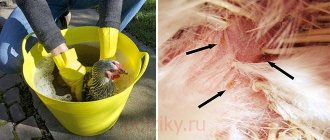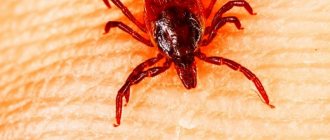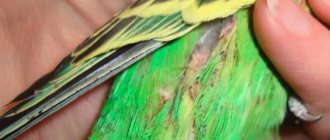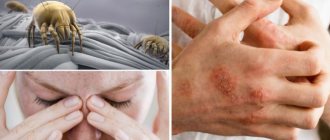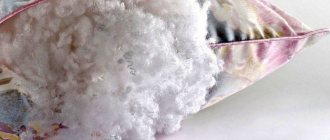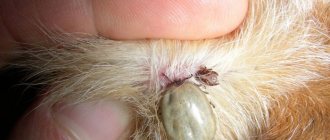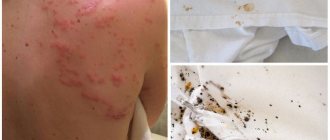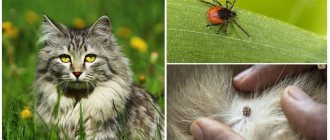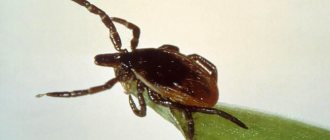Home » Articles about chickens » Mites on chickens
There are many known parasites that cause concern to poultry. The most dangerous mites for chickens are scabies, feather and red mites. Arachnids can parasitize feathers or skin.
Scabies mite in chickens
Scabies mites of the genus Knemidokoptes parasitize the thickness of the skin: K. mutans and K. laevis. They are microscopic in size. The disease caused by a subcutaneous parasite is called knemidocoptic mange.
Knemidokoptes mutans attacks the legs of birds. Arachnids sneak under the scales of the paws and gnaw through the passages. They feed on skin particles, lymphatic fluid, and inflammatory exudate. Knemidocoptes laevis infects the skin of the trunk. Parasites settle at the base of feathers and gnaw passages in the thickness of the skin.
Transfer methods
The scabies mite in chickens is transmitted through direct contact with sick birds, as well as through contaminated litter, care items, and a dry mixture in an ash-sand bath. Parasitic insects remain viable for a long time in fallen skin flakes. They survive without a host for up to two weeks during the summer season. In winter, vital processes are slowed down; adults remain viable for several months. During the life cycle, females hatch 6-8 larvae. Knemidokoptes most actively attacks birds in spring and autumn.
Symptoms of the disease
The colony of parasites grows gradually, so obvious signs become noticeable several months after infection. At first, the livestock shows restlessness only at night, but later the symptoms spread to daylight hours.
When the paws of chickens are infected by the Knemidokoptes mite, the scales rise, the skin becomes lumpy and rough. A “limestone” paw effect occurs. The colony grows when the bird’s immunity decreases - about 20 thousand individuals can simultaneously live on one leg. If left untreated, the fingers are severely affected - the tissues die, and the birds lose the ability to move normally. Self-pecking occurs due to severe itching. Open wounds get infected, which further complicates the situation.
The subcutaneous mite Knemidocoptes laevis causes itching throughout the body. Severe discomfort forces chickens to constantly clean their feathers and pluck them. They seem to eat ticks, but this is not the case - the insects are too small to be captured by their beaks.
Infection with any type of scabies mites leads to the following symptoms:
- ruffled plumage;
- restless behavior;
- loss of appetite;
- decreased productivity in laying hens;
- growth slowdown.
Treatment of knemidocoptosis
To get rid of the mite that parasitizes the legs of chickens, drugs are most often used that clog the passages gnawed into the skin. An antiseptic component may be added to prevent secondary infections. Acaricidal agents are also indicated. In treatment they use:
- boric petroleum jelly - apply to the affected areas once a day until the condition improves;
- birch tar - immerse the paws for 1 minute, repeat daily until the problem is solved;
- aversectin ointment - it causes the death of parasites at all stages of development, treatment is carried out twice at intervals of a week;
- ASD-3 - the composition is mixed with vegetable oil 1:1, used externally for a week.
To treat chickens against the Knemidocoptes laevis mite, the following are indicated:
- Neostomazan – feathers are sprayed with a solution of the drug (1:1000);
- Frontline (Fipronil) - the aerosol is sprayed, lifting the feathers against their growth, the procedure is repeated a week later.
Prevention
Measures to prevent infection with knemidocoptic mange:
- routine cleaning of the chicken coop;
- using sulfur bombs to destroy parasites and prevent their appearance;
- regular replacement of the contents of dry bathtubs in combination with firing of equipment or treating it with acaricidal agents.
Knepidocoptic mange
Avian acariasis, caused by mites of the genus Knemidokoptes, is characterized by itchy skin, dermatitis, necrosis of the phalanges, and decreased productivity.
Symptoms:
- inflammation, in severe cases tissue necrosis.
Pathogenesis
The disease occurs in several stages:
- The first stage is asymptomatic and lasts for 5-6 months . During this period, the mite penetrates the skin of the bird.
- The second stage of the disease lasts from one to two years . The phalanges of the chicken gradually become covered with small painful growths. Gradually, they begin to cause discomfort to the bird; it begins to limp when walking and often tuck its paws.
- The last stage can last several years . The chicken's feet become rough. The growths fall off, forming wounds from which a bloody-gray substance oozes. The bird is practically unable to walk.
Drugs for treatment
Use:
- Ectomin : thick liquid for preparing a solution. The active ingredient is a synthetic insecticide. The solution is prepared according to the instructions on the package, treatment is carried out within 5 days.
- Trichlorometaphos : the drug has an oily consistency. The active substance is pyrethroid. This component kills adult parasites and their larvae, and also cleans the canals that the tick has gnawed through.
- Butox : considered one of the most effective drugs for combating chicken mites. The active component is capable of destroying parasite larvae and greatly weakening adult individuals. The drug is available in ampoules, the contents of which are used to prepare the solution.
- Mara-sad : the drug is an oily solution. The product allows you to get rid of parasites and accelerates the process of skin regeneration.
- Akarin : the drug comes in the form of a gel that must be rubbed into the affected areas.
- Frontline : the medicine is sold in the form of a spray, which must be used to treat the affected areas of the skin.
Treatment and control of spread
The disease occurs in a mild form only at the first stage, then it becomes acute. The difficulty lies in the fact that at the beginning of the disease, the symptoms are usually blurred, and specific symptoms in the form of the formation of papules (lumps) appear later. Therefore, with a permanent course of the disease, treatment is most often not carried out. The disease in its acute form is treated with the above drugs, which are applied locally.
The duration of treatment and the frequency of treatment procedures depend on the severity of the disease and the characteristics of the drug.
Feather mites in chickens
There are several known species of ticks belonging to the genus Syringophilus. The disease they cause is called syringophilosis. Feather parasites affect any poultry. They are small in size (about 1 mm), penetrate through the channel at the base of the feather, and cause inflammation of the surrounding tissue. Infection occurs in the same way as in the case of skin mites. Fallen feathers become reservoirs that facilitate spread.
Most often, syringophilosis affects young individuals aged 5-7 months.
Symptoms of feather scabies (syringophilosis)
Signs of a parasitic disease become apparent 3 months after infection. In the poultry house, a lot of fallen feathers appear on the floor - due to the destruction of the frame, it breaks off. Birds become restless, disheveled, and constantly preen their feathers. Self-incriminations are becoming more frequent. Egg production decreases, weight gain decreases.
The diagnosis is made by studying the feathers. The interior becomes dark. When such a feather is found, it is pulled out and the edge is cut across. The contents are cleaned onto a white sheet of paper and examined with a magnifying glass. When affected by syringophilosis, dust-like dry contents of brown color are detected (these are traces of insect activity).
Treatment of feather mites in chickens
Treatment of broilers for syringophilia is usually not required. Before the moment of slaughter, the colony does not have time to grow to such a scale as to cause disturbance to the bird. When keeping laying hens, oral administration of the medication is recommended. A good effect is provided by the drug against feather eaters and ticks for chickens Ivermek OR. It is given in a dosage of 0.4 mg/1 kg of live weight with drinking water. The course consists of two doses of the drug with an interval of 24 hours. It is repeated after a couple of weeks. Prevention of infection is the same as in the case of scabies parasites.
External treatment is ineffective due to the fact that the edge creates reliable protection against arachnids. If a decision is made in favor of this method, then bathing is chosen instead of spraying the feathers. During the procedure, liquid penetrates the skin and microscopic holes in the shaft. This increases the chances of killing parasites.
Creolin shows good results. For adult chickens against ticks, the recommended dosage is 30 ml/20 l of water. Before diluting the drug, the water is heated to a comfortable temperature. The chicken is immersed in the prepared bath up to its neck, held for a couple of minutes, and the head is wetted with your hand (the liquid should not get into the eyes). The bird is removed, the water is allowed to drain and placed in a warm room that has been cleared of debris and treated with a creolin solution (2 ml/4 l). A dry bedding of straw is laid on the floor. The birds are kept there until they dry completely. After a week, the treatment is repeated.
Epidermoptosis
Acariasis of humans and poultry, caused by mites of the Epidermoptes family, is characterized by inflammation of the skin.
Symptoms:
- skin hyperemia;
- epithelial rejection;
- the appearance of foul-smelling crusts on the skin.
Pathogenesis
Focal lesions of the bird's skin occur in the head, neck, then back and thighs in the form of pronounced exfoliation of the epidermis, skin hyperemia, lymph secretion and the formation of crusts, the lower layer of which emits an unpleasant putrefactive odor. There is no itching. Feathers fall out in the affected areas. The bird experiences stress, its body weight and egg production decrease. If left untreated, death can occur.
Drugs for treatment
The following medications are used to relieve symptoms of the disease:
- tar and creolin ointment;
- tar with alcohol.
Treatment and control of spread
To date, treatment has not been sufficiently developed. It is recommended to treat the affected areas with the above drugs. Carry out the treatment 2-3 times with an interval of 5-6 days.
Cages, poultry house floors, and equipment must be desacarinized.
Chicken red mite
Avian red mite in chickens (Dermanyssus gallinae), unlike scabies and feather mites, belongs to the category of temporary ectoparasites. The insect feeds on the bird's body from half an hour to an hour a day, and spends the rest of the time in crevices and other secluded shelters near the food source.
Dermanyssus gallinae drinks blood only at night; the tick is not active during the daytime.
During development, the parasite goes through several stages before reaching its adult form (imago). The process takes no longer than two weeks. The speed of development depends on environmental conditions. At a temperature of 18-25 ° C and high humidity, the period can be reduced to six days. The adult lives for about a year. The clutch of females contains up to twenty eggs. Dermanyssus reproduce most actively in the summer. In an unfavorable environment, they fall into suspended animation and remain viable for about a year.
The blood-feeding ectoparasite is dangerous because it transmits many infectious diseases, including smallpox, pasteurellosis, and pseudoplague.
Dermanyssus enters the premises on the clothes and shoes of staff, with equipment, and with new individuals.
Signs of infection
The fact that the premises are contaminated is indicated by restlessness of the birds at night, exhaustion, slower growth, and a drop in productivity. Laying hens lay eggs with blood stains, and there is a tendency to self-pecking and cannibalism. Staff may develop hives-like rashes on their bodies.
Diagnostics
Having noticed signs of infection of the premises with ectoparasites, in the morning they install glue traps near possible places of their localization. The next morning, the traps are removed and inspected. If the suspicion of infection is confirmed, measures are taken to destroy the insects.
Treatment
The veterinarian will tell you what is the best way to treat chickens for mites. The most commonly used scheme is:
- on the first and fifth days of the course, chickens are fed with the anti-mite drug Ivermek OR (0.4 mg/1 kg of live weight) and large-droplet spraying of Ivermek-ON is carried out (the room, equipment and birds are treated);
- on the second and sixth days, give Ivermec OR (0.4 mg/1 kg of live weight), skip the aerosol treatment.
Days 3 and 4 – break from drinking and processing. The results are monitored by re-installing the traps. If necessary, the scheme is repeated.
Prevention
To clear the premises of red chicken mites, the chickens are relocated and disinfestation begins immediately. How to treat the chicken coop is decided taking into account the degree of infestation. Good results are provided by one percent Cyflunit-ON (consumption: 50-100 ml/sq.m). After processing:
- wash drinking bowls and feeders;
- clean and wash the room;
- surfaces are whitened with slaked lime.
After this, disinfestation is repeated and aerosol disinfection is carried out.
The first disinsection is carried out immediately after the eviction of the livestock, before the premises have had time to cool down - later the ticks hide deep in the cracks and are extremely difficult to destroy.
Prevention measures
Veterinarians agree that carrying out timely preventive work is much easier than fighting parasites.
Prevention of chicken mites involves keeping the chicken coop clean and regularly cleaning it. It is necessary to remove droppings in a timely manner, change the litter, keeping it dry, sweep away cobwebs, and pour boiling water over drinking bowls and feeders. A place for birds to walk must be organized in a well-lit place, preferably sprinkled with sand. The chicken coop must be disinfected at least once a month.
It is also necessary to check all packaging containers delivered from other farms. Metal containers for collecting eggs have a weak spot - a plastic gasket. It must be washed thoroughly using a cleaning agent.
It is imperative to inspect birds, especially from late spring to early autumn.
If birds are infected after treatment, it is necessary to thoroughly disinfect the poultry house. The litter should be removed and burned. Whiten the walls with freshly slaked lime or 5% Creolin solution. It is also recommended to use a blowtorch on all wooden surfaces of the chicken coop, as they harbor mite larvae.
If more than 10% of the herd is affected by the disease, it is recommended to replace the entire herd.
Ixodid ticks
Such parasites do not infect en masse. Birds may be harmed while walking. An ectoparasite that lives in the grass attaches itself to the victim, drinks blood, and then returns to its familiar environment. Females lay eggs and new individuals hatch from them. The cycle repeats.
Ixodid ticks are large in size and are easy to spot visually. In order not to harm the chicken, it is worth knowing how to properly rid it of ticks. It should not be pulled out abruptly, otherwise the dangerous contents of the abdomen will enter the blood, and the head will remain at the site of the bite. Using oil may cause the insect to burrow even deeper. Using tweezers, grab it as close to the proboscis as possible and carefully “twist” it from the body.
Definition of disease
Ticks are ectoparasites that feed on blood by attaching themselves to the skin of living organisms. They deplete the animal’s body, negatively affect the barrier functions of the skin, cause deterioration in the condition of the feather, and can lead to the development of various dangerous infections. Parasites are especially active in the summer. In chickens, they settle in feather pouches, on the paws, in skin follicles and folds of the epidermis. Find out about mini meat chicken breeds in this article.
Symptoms of infection:
- apathy and weakness;
- sores, wounds, scratches and sores;
- shortness of breath, dry frequent cough;
- pallor of earrings, comb, mucous membranes;
- cessation of egg laying;
- weight loss;
- thirst, refusal to eat.
When infected with mites, small spots of red and black are usually visible on the body of the bird, and there are droplets of blood on the feathers.
The sooner you start fighting blood-sucking parasites, the better, since in favorable conditions they multiply very actively, and even one bird can lead to damage to the entire flock and significant financial losses. As a rule, adults do not want to enter an infected chicken coop, and the chicks simply die in the first week of life. Find out about Iodinol for laying hens here.
Varieties
Chickens are parasitized by various mites. Let's look at them.
Large
Large ticks can be easily seen; visually and in size they are similar to fleas. Varieties:
- Ixodidae - affects not only humans, but also animals.
- Persian - Argasaceae, a purely avian parasite.
- Reds attack chickens only for food, the rest of the time they simply live and breed in the poultry house.
The red tick is considered the most dangerous - it carries viruses, bacteria, spreads typhoid, cholera, spirochitosis, and borreliosis.
The red chicken mite is most often found in chicken coops. The parasite has a brown body 0.6-0.7 mm in length; after filling with blood it turns purple. The female lays up to 20 eggs per day. The main activity is from early May to mid-autumn. The life cycle of a tick lasts 6-13 days. The parasite loves humidity and warmth. Find out about the care and raising of Phoenix quails in this material.
Microscopic
The first group of parasites are microscopic. You can't just see them. Kinds:
- Knemidocoptes - cause the appearance of body and leg scabies.
- Epidermoptes is a microorganism that causes skin-beeting scabies pathology.
- Cytodites is a pulmonary or tracheal micromite that feeds on epidermal secretions and particles of cellular structures.
Methods of controlling parasites
In order to get rid of ticks on chickens, farmers lubricate the bites with oil on those parts of the birds' body on which unhealed wounds and legs are visible. After a couple of days the tick dies. The wounds are disinfected and coated with cream, which promotes rapid healing. The poultry house must be cleaned and disinfected, and the chickens, after suffering from illness and treatment, must be moved to a dry, ventilated room. As a result, the dangerous red chicken mite will be completely destroyed.
There are many methods that make fighting ticks easy and effective. Effective ways to combat ticks are:
- Treatment of a chicken flock begins with treating the skin of the birds with special medicinal agents. The procedure is carried out twice a week at weekly intervals. Sevin powder is the best remedy for chicken feather mites. Feathers are sprinkled with a powder preparation, and birds and their habitat are sprayed with disinfectant sprays.
- Sand and ash are the best natural remedies to completely get rid of pests. The 2 ingredients are mixed, and then the mixture is poured into a glass container. The container with the product is placed in the yard. Chickens in close proximity to the product will independently clear themselves of ticks. Soon you won't have to worry about the problem of mites.
- Feather mites do not tolerate too high temperatures, so it would be a good idea to treat the floor and walls of the chicken coop with boiling water, a flame (if the house is not wooden) or a blowtorch. Quartz lamps do an excellent job of killing mites; this method is used on large poultry farms. At home, it is also suitable for insect control.
- Plants will help remove such aliens. Mint, parsley, onion, celery and garlic are laid out in the chicken coop (along the entire perimeter). Specific odors will quickly drive pests away from the poultry house.
Treatment with sprays and aerosols should not be used without consultation with specialists. The veterinarian will accurately prescribe medication and tell you in detail how to fight chicken mites at home without harming the birds.
Bird ticks are dangerous. Pests carry serious diseases: plague, borreliosis and cholera. If appropriate treatment and prevention measures are not taken, the birds will die and harm humans.
Signs of a bird being affected by parasites
You can notice that mites have appeared on the body of the bird by the following signs:
- First, the structure of the skin changes;
- secondly, the skin color becomes darker or sharply lighter; feathers begin to fall out or break, stripes of dark color appear on their surface;
- Thirdly, the behavior of chickens changes - they become more restless, engage in self-pecking and scratch their skin. This indicates that the bird is experiencing pain and itching.
Also, mites can live not only in the plumage of birds, but also in the chicken coop itself - mainly in the litter, where parasites multiply and their offspring grow up there.
Causes of mites in poultry houses
New birds
Sometimes parasites can get into the poultry house due to non-compliance with quarantine rules. Purchased birds must be kept separately from the main flock for up to 14 days, and any contact should be completely excluded.
If a poultry farmer neglects this rule, he may face infection of the entire population.
Farmer's clothing, equipment, bedding, feed
A person himself can accidentally introduce ticks into the poultry house if parasites remain on his clothes, shoes or tools. There is also a risk of purchasing contaminated items, cells, especially if they have already been used. Poultry feed can be contaminated if it is not stored properly and if wild birds and rodents have access to it.
Room
If sick chickens were previously kept in the premises, then there is a high risk of infection of the new flock. Ticks are very tenacious, and the most severe pest control methods may be required to destroy their eggs.
Infected animals and birds
Outside the poultry house, chickens are in contact with the external environment. They may also encounter wild birds or animals that may be carriers of ticks. Moreover: some parasites are capable of not feeding for a long time, so in theory, a chicken can become infected even in the absence of direct contact. For example, through grass on which ticks have fallen from the body of a wild bird. It is almost impossible to control this route of infection, so we recommend regularly inspecting chickens and paying attention to the integrity of their plumage and oddities in their behavior.
